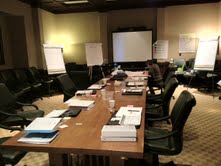23 Jun How to Conclude a Meeting

Be sure to leave enough time in the agenda to do this, and focus on the following:
1. Review Progress – Where appropriate, review the work that was done in the meeting; this is a great way to emphasize how productive the time was as you conclude a meeting. This is particularly important when meetings take place over many hours or even days, such as Strategic Planning. There is nothing more visually rewarding than a wall full of flip charts that illustrate all the work that was completed and decisions that were made.
“There is nothing more visually rewarding than a wall full of flip charts…”
2. Review Issues Parking Lot – Make sure this parking lot is empty before everyone leaves the meeting. All items should either have been covered during the meeting (make sure everyone agrees this is true), or they need to be added to the action list with a due date and responsible person identified.
3. Review Personal Goals – Remember at the opening of the meeting it was suggested that the participants are asked what they want to get from the time together? This is where those goals and objectives are reviewed. Read them one by one and ask if this has been covered. If all goes well, every participant will feel they have met their personal objective. As a result, they will feel very satisfied that the meeting was productive. If something has not been covered, as the facilitator, decide whether it can be taken care of with a quick discussion or if there is a separate action that needs to be taken.
4. Actions – Before everyone leaves the meeting, ensure that follow up actions are clearly defined for each individual. These can be the actions captured on the parking lot, or individual actions such as distributing notes, setting the next meeting, informing others of what happened during the meeting, etc. The closer you can get to every participant leaving with an action, the better.
5. Plus / Delta – In the spirit of continuous improvement, feel free to do a quick poll of what the participants liked or would like to change for the next time. This way you have an opportunity to make the meetings even more effective as the participants will feel more vested in their success.
p.s. Don’t forget to follow up!
The meeting was a success and everyone in the room took on action items. It is important now that everyone is held accountable to follow through on those actions. The meeting organizer’s responsibility is to keep track of when actions were due and who was responsible, and follow up with them at the appropriate time to make sure everything is on track. If certain actions are not completed before the next meeting you have great topics for the next agenda!
Do your managers know how to conclude a meeting? Do they need practical skill development?
Related Articles
Ready to fearlessly provide feedback and get positive results?
Our Fearless Leaders MasterClass® Program will help you develop the emotional intelligence and leadership skills needed to have effective conversations.
Sign up to reduce manager overwhelm and employee turnover.




